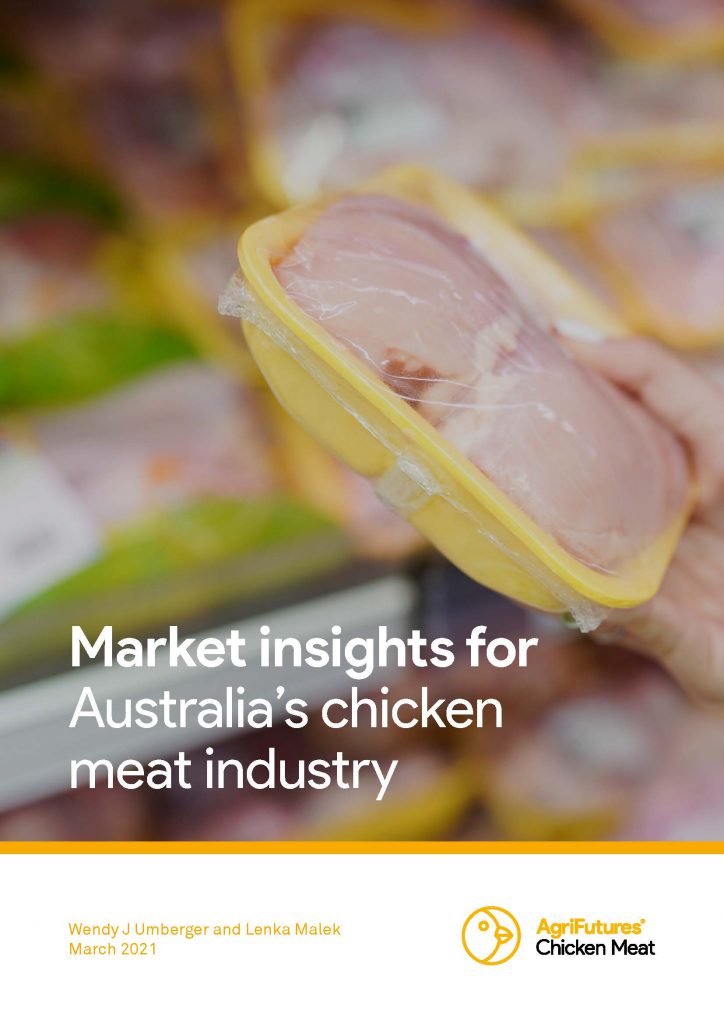Growth in per capita consumption of chicken meat continues to outpace demand for other meats in Australia’s dynamic meat market. In the process of supplying the chicken meat needs of the nation, the Australian chicken meat industry contributes significantly to the Australian economy. This study helps the industry by providing an understanding of the current demand drivers for chicken meat, and the future opportunities for the industry in the domestic meat and protein market.
As part of a three year project (2017 – 2020) online surveys of nationally representative samples of Australian consumers were conducted in 2019 (referred to throughout this report as the 2019 survey). Survey results provide current insights into consumer usage and attitudes towards Australian chicken meat. The 2019 responses are compared to data from a 2008 Australian chicken meat usage and attitudes study. In-depth interviews with South Australian consumers provide deeper insights into chicken meat purchase drivers, and consumer understanding and use of labelling on chicken meat products.
Chicken consumption behaviour with respect to household and personal consumption frequency and purchasing behaviour (including cut preferences) has not changed significantly since 2008. Chicken continues to be the most frequently consumed meat product in the average Australian household. The appeal of chicken to Australian consumers continues to centre on its convenience, price/value for money, and popularity among household members of all ages. However, consumers’ reasons for increasing their chicken meat consumption have changed somewhat over time. Compared to 2008, a higher share of consumers in 2019 reported increasing their chicken consumption because they perceive chicken to be cheaper than other meats, easier to prepare, healthier/lower fat than other meats, and also because of the greater availability of chicken-based ready meals and animal welfare-friendly chicken products. More consumers in 2019 were reducing their chicken meat consumption. This was primarily as part of an overall reduction in meat consumption. Other reasons given for eating less chicken overall were concerns about animal welfare and environmental impact.
Australian consumers are generally satisfied with the safety and eating quality of chicken meat, and currently, they do not have strong concerns about the impact of chicken meat production on animal welfare and the environment.
General consumer understanding of chicken meat production practices remains poor, especially about the use of hormones/steroids and cages (neither of which are used in Australian chicken production), use of antibiotics, and country of origin. Consumers continue to trust government sources above all others for information on the production and safety of chicken meat.
When shopping for chicken meat, most consumers say they are driven by price, cut, ‘free range’, and country of origin. Labelling related to production methods is not a strong purchase driver for most consumers – they generally have a low level of (perceived) understanding and trust in such labels. Nonetheless, consumers indicate that they are paying more attention to product packaging/labelling information and that they are using this information to guide their meat choices.
Overall, the consumer trends that are likely to affect future demand for chicken meat include the following: growth in the number of consumers limiting or reducing their meat consumption; developing interest in production-related credence attributes (e.g. free range, animal welfare, antibiotic use); increasing concerns about animal welfare; and emerging concerns about the environmental impact of meat production.
Demand for chicken meat in Australia is likely to continue to grow as more consumers replace other meat products, e.g. beef and lamb, with relatively more affordable chicken meat. For chicken to remain the most popular meat for the average Australian household, the industry needs to continue to offer chicken meat products that provide versatility and good value for money, and deliver consistently good eating quality.
Ensuring consumers have access to healthy, convenient and animal welfare-friendly chicken products could help to grow overall consumption. The challenge for the industry will continue to be gaining the attention of consumers and effectively communicating facts.





